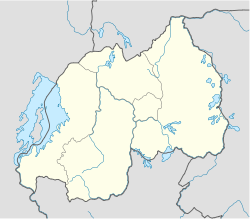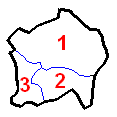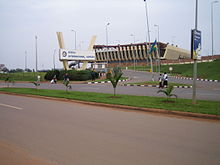
Kigali
Did you know...
SOS Children has tried to make Wikipedia content more accessible by this schools selection. Click here to find out about child sponsorship.
| Kigali | |
|---|---|
| Kigali, Rwanda | |
|
|
|
| Coordinates: 1°56′38″S 30°3′34″E Coordinates: 1°56′38″S 30°3′34″E | |
| Country | Rwanda |
| Province | Kigali City |
| Government | |
| • Mayor | Fidele Ndayisaba |
| Area | |
| • Total | 730 km2 (280 sq mi) |
| Elevation | 1,567 m (5,141 ft) |
| Population (2009) | |
| • Total | 965,398 |
| • Density | 1,165.8/km2 (3,019/sq mi) |
| estimated | |
| Time zone | CAT ( UTC+2) |
| • Summer ( DST) | none ( UTC+2) |
| Districts 1. Gasabo 2. Kicukiro 3. Nyarugenge |
|
| Website | www.kigalicity.gov.rw |
Kigali, with population of almost 1 million (2009), is the capital and largest city of Rwanda. It is situated near the geographic centre of the nation. The city has been the economic, cultural, and transport hub of Rwanda since it became capital at independence in 1962. The main residence and offices of the President of Rwanda are located in the city, as are the government ministries. The city is coterminous with the province of Kigali City, which was enlarged in January 2006, as part of local government reorganisation in the country. The city's urban area covers about 70% of the municipal boundaries. The city population has varied around the national percentages: Hutu 84%, Tutsi 15% and Twa (Pygmy) at 1%.
History
Kigali was founded in 1907 under German colonial rule, but did not become the capital until Rwandan independence in 1962. The traditional capital was the seat of the mwami (king) in Nyanza, while the colonial seat of power was in Butare, then known as Astrida. Butare was initially the leading contender to be the capital of the new independent nation, but Kigali was chosen because of its more central location. Since then the city has grown very quickly and is now the major political, economic and cultural centre of Rwanda.
Beginning on April 6, 1994, Kigali was the scene of the Rwandan Genocide – the slaughter of approximately one million Tutsi and moderate Hutu by Hutu militias ( interahamwe), and some members of the Rwandan army. There was fierce fighting between the army (mostly Hutu) and Tutsi-dominated Rwandese Patriotic Front. Although damaged, the city's structure has recovered.
Geography
The city is built in hilly country, sprawling across about four ridges and the valleys in between. The city centre is located on one of these ridges, with the main government area on another. The tops of the ridges have an average elevation of 1,600 metres (5,250 ft), while the valleys are around 1,300 m (4,270 ft). The bigger houses and office buildings tend to be on the tops of the ridges, while the poorer people live in the valleys. The city is ringed most of the way round by higher hills, with some suburban sprawl rising up these. The highest of these is Mt. Kigali, with an elevation of 1,850 m (6,075 ft) above sea level.
| Climate data for Kigali, Rwanda | |||||||||||||
|---|---|---|---|---|---|---|---|---|---|---|---|---|---|
| Month | Jan | Feb | Mar | Apr | May | Jun | Jul | Aug | Sep | Oct | Nov | Dec | Year |
| Average high °C (°F) | 26.9 (80.4) |
27.4 (81.3) |
26.9 (80.4) |
26.2 (79.2) |
25.9 (78.6) |
26.4 (79.5) |
27.1 (80.8) |
28.0 (82.4) |
28.2 (82.8) |
27.2 (81) |
26.1 (79) |
26.4 (79.5) |
26.89 (80.41) |
| Average low °C (°F) | 15.6 (60.1) |
15.8 (60.4) |
15.7 (60.3) |
16.1 (61) |
16.2 (61.2) |
15.3 (59.5) |
15.0 (59) |
16.0 (60.8) |
16.0 (60.8) |
15.9 (60.6) |
15.5 (59.9) |
15.6 (60.1) |
15.73 (60.31) |
| Precipitation mm (inches) | 76.9 (3.028) |
91.0 (3.583) |
114.2 (4.496) |
154.2 (6.071) |
88.1 (3.469) |
18.6 (0.732) |
11.4 (0.449) |
31.1 (1.224) |
69.6 (2.74) |
105.7 (4.161) |
112.7 (4.437) |
77.4 (3.047) |
950.9 (37.437) |
| Avg. precipitation days (≥ 0.1 mm) | 11 | 11 | 15 | 18 | 13 | 2 | 1 | 4 | 10 | 17 | 17 | 14 | 133 |
| Source: World Meteorological Organization | |||||||||||||
Cityscape
Kigali houses several memorials, museums, and centers dedicated to the Rwandan Genocide, including the Kigali Genocide Memorial Centre. Other museums include the National Museum of Rwanda and Kandt House Museum of Natural History.
Urugwiro is the official residence of the President of Rwanda. It constitutes an entire village within the Kacyiru distrct of Kigali.
The city has international class hotels, some played a role in history:
- The Mille Collines in the Kiyovu area. This hotel became a refugee centre during the genocide, as famously depicted in the film Hotel Rwanda (although the hotel shown in the film is in fact in South Africa). It is also the setting for the famous novel Un dimanche à la piscine à Kigali, by Quebecer Gil Courtemanche, and its movie adaptation Un dimanche à Kigali.
- The Kigali Serena Hotel, formerly known as the InterContinental Kigali. Formerly a Belgian-owned hotel known as the Diplomates, the hotel was briefly portrayed in the second half of Hotel Rwanda. It was later bought by the InterContinental Hotels group and remodeled in 2003.
Economy
Tin ore ( cassiterite) has been mined nearby, and the city built a smelting plant in the 1980s. Business in Rwanda has been growing, and many new buildings have emerged across the city, including the BCDI Tower, Centenary House and Kigali Tower. Tourism provides important input into the economy also.
Rwanda's real GDP growth averaged 8.3 percent between 2002 and 2009. Per capita GDP swelled those years from $206 to $520, or 252% higher. While 47 percent of Rwandans enjoyed clean water in 2000, 75 percent were so fortunate in 2010. While 78 percent of the country was considered poor in 1995, that number stood at 57 percent in 2009.
Education
Lycée de Kigali is the second-largest secondary school in Rwanda, after the Groupe Scolaire in Butare.
Green Hills Academy, in the upscale suburb of Nyarutarama, is a top private school, offering IB at A level, and the Cambridge International Program at O level. It is a PASCH partner school offering German. It has a 50/50 English-French curriculum as well. École Antoine de Saint-Exupéry de Kigali, the French school, is in Kigali. École Belge de Kigali, the Belgian school, is in Kigali. International School of Kigali is also in Kigali. The Earth School -the International Montessori School of Rwanda- is a private preschool and elementary program serving children ages 3-12.
Kigali Independent University has a Kigali campus.
Transportation
The city has an international airport, Kigali International Airport, with passenger flights to (among others) Amsterdam, Brussels, Nairobi, Entebbe, Johannesburg, and Istanbul (with Turkish Airlines). The airport is somewhat limited by its location on the top of a hill, and a brand new one is being considered in the Nyamata area, some 40 kilometres (25 mi) from Kigali.
There are several daily coach services which depart from Kigali to destinations in East Africa. Most leave from the Nyabugogo bus station. These services include:
- Jaguar Executive Coaches, which connects Kigali to Kampala, the Ugandan capital, via Gatuna or via Kayonza and Kagitumba.
- Akamba Bus Services, which runs services to Kampala (8 hours), Nairobi in Kenya (24 hours), Dar es Salaam in Tanzania (36 hours) and Mombasa in Kenya (32 hours)
- Onatracom Express - a Rwandan government service using quite basic buses, running between Kigali and Kampala.
- Yahoo Car Express - A minibus service running between Kigali and Bujumbura in Burundi.
- Kampala Coach Ltd, which runs services to Kampala (8 hours), Nairobi in Kenya (24 hours), Dar es Salaam in Tanzania (36 hours)and Mombasa in Kenya (32 hours).
Kigali is the hub of the Rwanda transport network, with hourly express bus routes to all major towns in the country. The major nationwide companies are Atraco, Stella, Omega, Okapi, Impala (minibuses), and Onatracom, which offers a big bus service, while Volcano Express (to Butare), Virunga Express and Onatracom (to Ruhengeri), Muhabura Express (to Ruhengeri and Gisenyi) serve specific destinations and follow a set schedule. There are also taxi minibus services ( matatus) leaving from Kigali, which also go through to the major towns, but some of them stop frequently along the route to pick people up or drop them off.
Public transport within Kigali is exclusively by taxi minibus ( matatu) routes, connecting the main hubs of Mu ( Mujyi) in the city centre, Nyabugogo, Kacyiru, Kimironko and Remera. Similar to the national taxi minibuses, these services wait to fill up before setting off from the terminus, then pick up and drop off frequently en route.
Kigali has many taxis (known as 'special hire' or 'taxi voiture'), which are generally painted white with an orange stripe down the side. There are also motorbike taxis ('taxi moto'), which offer a service similar to a taxi, but for lower prices, typically in the range 300-1000 FRW.
Administration and government
Kigali is a province-level city governed by a city council who appoints an executive committee to run the day-to-day operations of the city. The executive committee consists of a mayor and two deputies. The city is split into three administrative districts: Gasabo, Kicukiro, and Nyarugenge. It contained parts of the former province of Kigali Rural.
Sister cities
 Kampala, Uganda
Kampala, Uganda San Bernardino, United States
San Bernardino, United States











